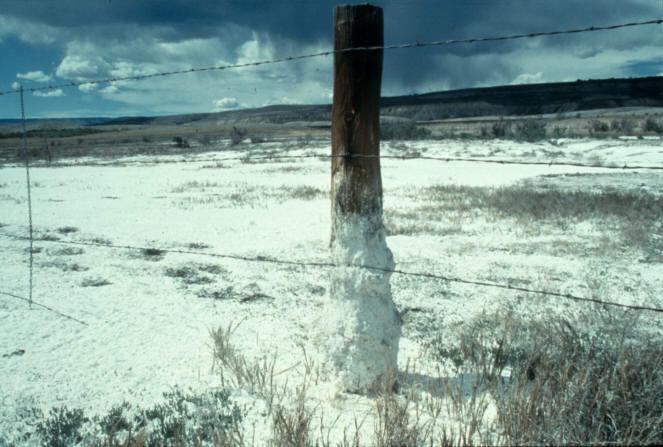Salinity in Agriculture
Salinity problems reduce productivity
on both irrigated and non-irrigated agricultural lands
in the United States and throughout the world.
 |
Salt-affected
soils on Colorado range land. High annual
evaporation (and/or transpiration), low annual
precipitation and restricted soil drainage,
combine to create salt affected soils in
depressions or lowlands. As the water
evaporates, salts dissolved from the soil
deposit and accumulate at the soil surface.
Notice the crust of salt deposited on the ground
and on the base of the fence post. |
| In California's
Coachella Valley, irrigation applications and
sub-surface drain lines are managed to reduce
the effects of soil salinity on crop land.
Lettuce in the foreground is sprinkler
irrigated. Bare patches in the field in the
background show localized effects of salinity. |
 |
|
Links to Salinity web sites
USDA-NRCS National Water and Climate Center
Management of Saline/Sodic Soils:
 Course material from the USDA- NRCS training course,
Management of Saline and Sodic Soils (1991), a series of
five Training Notes by Dr. James D. Rhoades, USDA-ARS
Salinity Laboratory, Riverside, California.
Course material from the USDA- NRCS training course,
Management of Saline and Sodic Soils (1991), a series of
five Training Notes by Dr. James D. Rhoades, USDA-ARS
Salinity Laboratory, Riverside, California.
Training Note 1: Determining Soil Salinity in the
Field From Measurements of Electrical Conductivity
Training Note 2: Effects of Salts on Soils and Plants
Training Note 3: Assessing the suitability of Saline
Water for Irrigation
Training Note 4: Practices to Control Salinity in
Irrigated Soils
Training Note 5: Strategies to Facilitate the Use of
Saline Waters and to Maximize the Beneficial Use of Multiple
Water Supplies for Irrigation
Saline-Seep Diagnosis, Control, and Reclamation:
 USDA-ARS Conservation Research Report No. 30, Issued May
1983.
USDA-ARS Conservation Research Report No. 30, Issued May
1983.
USDA-NRCS Soil Quality Institute
Soil Quality Test Kit Guide
The Soil Quality Test Kit Guide (prepared by NRCS and ARS)
is an 82-page booklet containing procedures for 12 on-farm
tests, an interpretive section for each test, data recording
sheets, and a section on how to build the kit. Chapter 5
includes an electrical conductivity test for salinity. See
Section II for salt tolerance of selected crops.
USDA-NRCS Plant Materials Program
HortNote No. 5, SALT-AFFECTED SOILS: THEIR CAUSES, MEASURE,
AND CLASSIFICATION
 Before installing salt-tolerant plants or reclaiming a
salt-affected site, landowners and managers need good
analytical information to create a strong conservation plan.
The latest HortNote issue, Number 5, from the Plant
Materials Center at Bridger, Montana, examines causes of
salt-affected soils, several tests used to measure
saltiness, and various classifications of salt-affected
soils. Soil salt levels can greatly influence plant survival
and growth. The effect of high-salt soils in the Northern
Plains and Rocky Mountains, for example, is dramatic. It is
estimated that 300,000 acres in Montana alone have been
removed from production because of increased salinity. Even
soils classified as “slightly saline” are marginally
acceptable for many crops. The next issue of HortNote will
continue this theme, addressing plant tolerance to salt
accumulation.
Before installing salt-tolerant plants or reclaiming a
salt-affected site, landowners and managers need good
analytical information to create a strong conservation plan.
The latest HortNote issue, Number 5, from the Plant
Materials Center at Bridger, Montana, examines causes of
salt-affected soils, several tests used to measure
saltiness, and various classifications of salt-affected
soils. Soil salt levels can greatly influence plant survival
and growth. The effect of high-salt soils in the Northern
Plains and Rocky Mountains, for example, is dramatic. It is
estimated that 300,000 acres in Montana alone have been
removed from production because of increased salinity. Even
soils classified as “slightly saline” are marginally
acceptable for many crops. The next issue of HortNote will
continue this theme, addressing plant tolerance to salt
accumulation.
The HortNote electronic newsletter provides timely
information on a variety of plant and conservation
horticulture topics, such as windbreak design, installation,
protection, and maintenance; species selection; greenhouse
operations; plant propagation and production; and native,
low maintenance, and xeriscape landscaping. Past issues are
available on the Plant Materials Program Web site
- select Publications, select Bridger, MT, select
Newsletters.
American Society of Civil Engineers
USDA-ARS George E. Brown Salinity
Laboratory
Colorado River Board of
California
Utah State University
New Mexico State University
Colorado State University
Cooperative Extension Service:
North Dakota State
University Extension Service:
University of
California, Davis
Australian Academy of
Science
|
